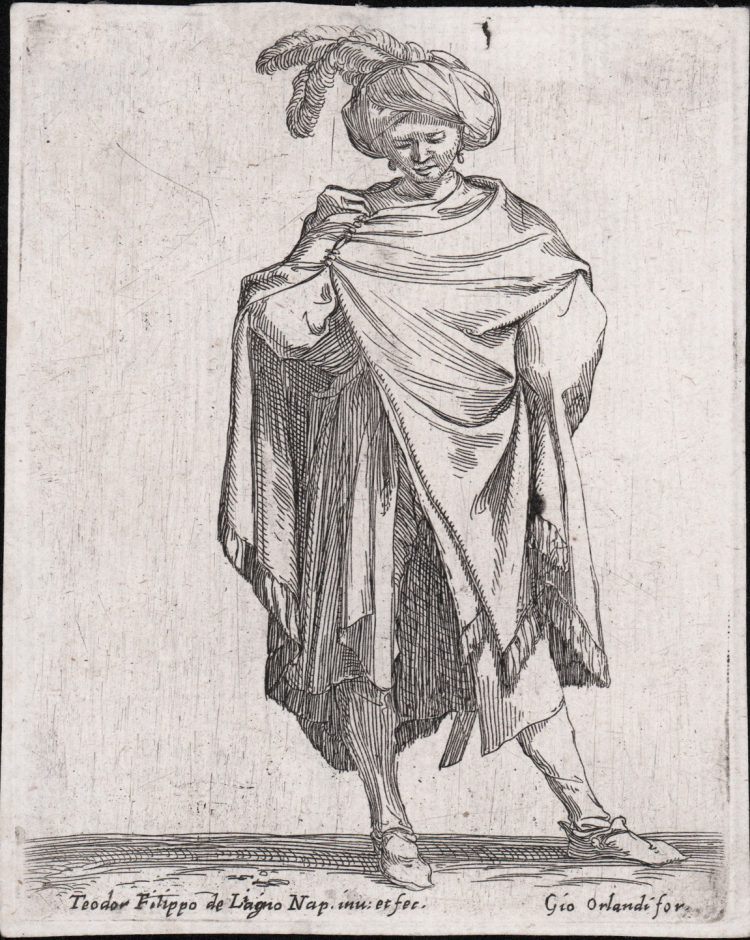



| Reference: | S45119 |
| Author | Teodoro Filippo di LIAGNO detto "Filippo Napoletano" |
| Year: | 1622 ca. |
| Measures: | 95 x 120 mm |


| Reference: | S45119 |
| Author | Teodoro Filippo di LIAGNO detto "Filippo Napoletano" |
| Year: | 1622 ca. |
| Measures: | 95 x 120 mm |
Soldier with a cloak and turban. Etching, circa 1622, lettered along the bottom 'Teodor Filippo de Liagno Nap inv et fec. Gio Orlandi for'
From the series Capricci e Habiti Militari.
A good impression of the first state – with Orlandi imprint - printed on contemporary paper without watermark, thin margins, in good condition.
The scarcity of information on the author's life and the rarity of his engravings makes it very difficult to catalogue his works. According to some scholars, Liagno took an interest in engraving, perhaps following a meeting in Florence with Jacques Callot. According to others, there is no affinity, other than stylistic, between the two artists.
The series of Capricci e Habiti Militari is the artist's most important and best-known work; it consists of 12 plates depicting individual figures of soldiers in different poses. The cataloguing of the series is rather confused due to the addresses of Giovanni Orlandi, a publisher active in Rome, which differ from plate to plate. Recent studies tend to catalogue only two states or editions: the first bearing Orlandi's name and the second De Rossi's. However, it is possible that this is an ante litteram proof, edited by the artist himself and predating his collaboration with Orlandi.
Liagno's series of engravings would have a fundamental impact on the next and most celebrated series of military figures: the Figurine by Salvator Rosa.
Liagno was an Italian painter and engraver. From 1600 until at least 1613 he was in Naples, where the naturalism of landscape painters from northern Europe, particularly Paul Bril, Goffredo Wals and Adam Elsheimer, influenced his early development. After 1614 he was in Rome and became acquainted with the landscapes and seascapes of Agostino Tassi. In 1617 Cosimo II de’ Medici summoned him to Florence, where he worked closely with Jacques Callot. Filippo sketched in the Tuscan countryside, and pen-and-wash drawings such as the Landscape with a Rustic House (Florence, Uffizi) capture effects of bright sunlight. He developed a new kind of realistic landscape, showing small scenes that suggest the charm of country life; examples are the Country Dance (1618; Florence, Uffizi), the Mill (Florence, Pitti) and the Fair at Impruneta (Florence, Pitti). In 1620–21 he produced a series of etchings of Skeletons of Animals, dedicated to the scientist Johann Faber, and in 1622 twelve etchings of Caprices and Military Uniforms (signed Teodor Filippo de Liagno). He was interested in macabre subjects and had a small Wunderkammer, or museum of curiosities.
Bibliografia
Bartsch, Le Peintre graveur (XVII.202.12).
Teodoro Filippo di LIAGNO detto "Filippo Napoletano" (Attivo a Napoli all’inizio del XVII secolo)
|
Italian painter and engraver. From 1600 until at least 1613 he was in Naples, where the naturalism of landscape painters from northern Europe, particularly Paul Bril, Goffredo Wals and Adam Elsheimer, influenced his early development. After 1614 he was in Rome and became acquainted with the landscapes and seascapes of Agostino Tassi. In 1617 Cosimo II de’ Medici summoned him to Florence, where he worked closely with Jacques Callot. Filippo sketched in the Tuscan countryside, and pen-and-wash drawings such as the Landscape with a Rustic House (Florence, Uffizi) capture effects of bright sunlight. He developed a new kind of realistic landscape, showing small scenes that suggest the charm of country life; examples are the Country Dance (1618; Florence, Uffizi), the Mill (Florence, Pitti) and the Fair at Impruneta (Florence, Pitti). In 1620–21 he produced a series of etchings of Skeletons of Animals, dedicated to the scientist Johann Faber, and in 1622 twelve etchings of Caprices and Military Uniforms (signed Teodor Filippo de Liagno). He was interested in macabre subjects and had a small Wunderkammer, or museum of curiosities.
|
Teodoro Filippo di LIAGNO detto "Filippo Napoletano" (Attivo a Napoli all’inizio del XVII secolo)
|
Italian painter and engraver. From 1600 until at least 1613 he was in Naples, where the naturalism of landscape painters from northern Europe, particularly Paul Bril, Goffredo Wals and Adam Elsheimer, influenced his early development. After 1614 he was in Rome and became acquainted with the landscapes and seascapes of Agostino Tassi. In 1617 Cosimo II de’ Medici summoned him to Florence, where he worked closely with Jacques Callot. Filippo sketched in the Tuscan countryside, and pen-and-wash drawings such as the Landscape with a Rustic House (Florence, Uffizi) capture effects of bright sunlight. He developed a new kind of realistic landscape, showing small scenes that suggest the charm of country life; examples are the Country Dance (1618; Florence, Uffizi), the Mill (Florence, Pitti) and the Fair at Impruneta (Florence, Pitti). In 1620–21 he produced a series of etchings of Skeletons of Animals, dedicated to the scientist Johann Faber, and in 1622 twelve etchings of Caprices and Military Uniforms (signed Teodor Filippo de Liagno). He was interested in macabre subjects and had a small Wunderkammer, or museum of curiosities.
|